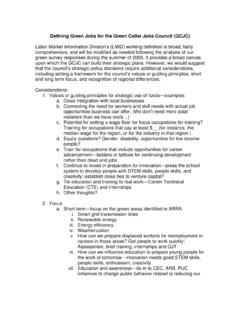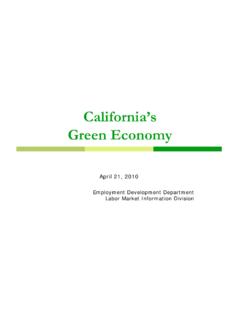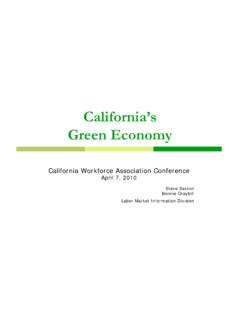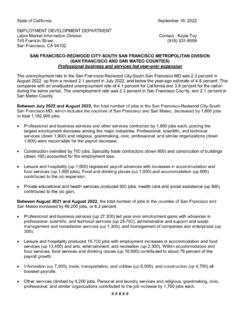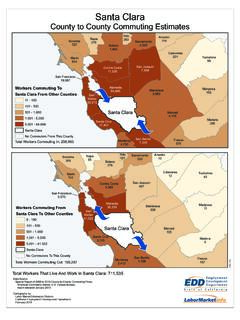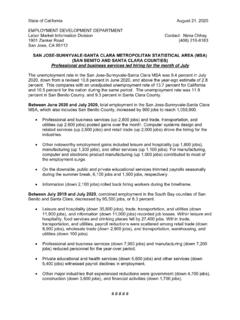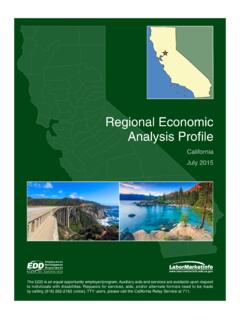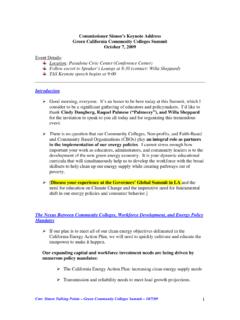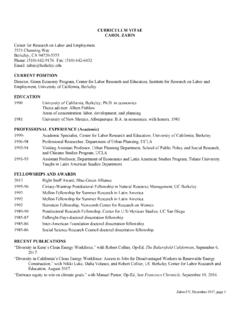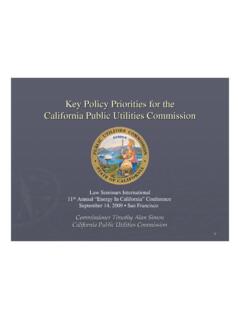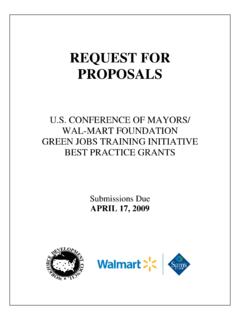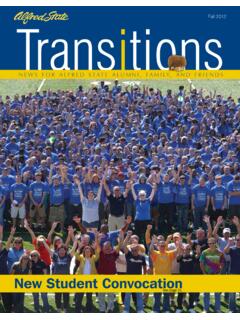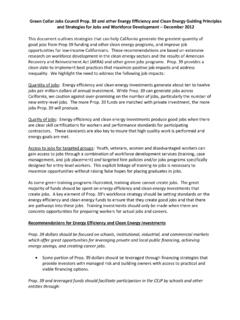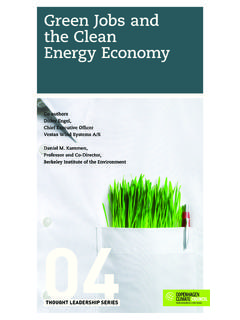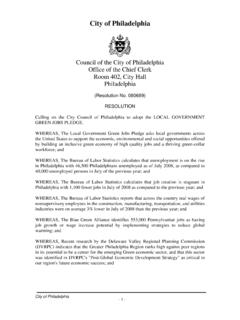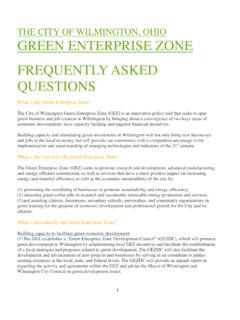Transcription of California’s Green Economy
1 california s Green EconomyGreen collar jobs CouncilDecember 8, 2009 Bonnie Graybill,Deputy Division ChiefCalifornia Labor Market Information DivisionUnderstanding the Green EconomyWhat is california LMI Doing/Planning? Collaborate to expand knowledge with federal/state/local research partners to review existing research and identify information gaps with state and local partners to define workforce needs and support workforce development with control entities and utilities responsible for bringing about climate change Respond to state and national information needs Share knowledge across agencies and geographic areas Host a shared Green web page that addresses existing research, survey methods and tools; national, state and local activities; legislation.
2 See our page at Survey california businesses to establish baselines of Green employment and Green business practices Conduct and publish career research to support workforce developmentNational Partnerships and Learning National Workforce Information council (WIC) Green jobs Study Group WIC commissioned the Green jobs Study Group to define and recommend methods for measuring Green jobs Eight states including california , BLS, O*NET (briefly) (Not as easy as it ) See Study Group reports. Workforce Information council web site Green jobs page Final report of the Workforce Information council Green jobs Study Group of Labor Learning Occupational Information Network(O*NET) Green Economy Sector Green enhanced skills Green increased demand New and emerging Green Bureau of Labor Statistics(BLS) plans to study the Green Economy include Industry survey adapted from Quarterly Census of Employment and Wages (QCEW) Annual Refile Survey Occupational survey adapted from Occupational Employment Statistics (OES)
3 Survey Develop career information materials Beginning in 2010- 2011 New Resources and OpportunitiesEmployment and Training Administration Green Economy LMI Improvement Grant Competition Notified in mid November that our state proposal would be funded. Planned activities include: Analyzing the results of our Green employer survey currently being conducted Conducting Green occupational skills research; Improving skills transference by evaluating occupational skill assessment tools, defining the relationships between assessment results and occupational characteristics, and automating the connection of these results to available labor market information; Creating an online statewide Green training inventory; and Improving electronic information delivery through enhancements to the Labor Market Information Division s information technology data as of October 8, 2009 Our Working Definition of GreenGreen jobs produce ( supply ) goods or services that result in: Generating and storing renewable energy Recycling existing materials Energy efficient product manufacturing, distribution, construction, installation, and maintenance Education, compliance and awareness Natural and sustainable product manufacturingFor the complete definition see.
4 Practices Increase DemandImportant LMID s definition focuses on the supply side Sustainable business practices (the demand side) are equally important to california s Green Economy Demand leads to increased pressure for additional supply of products and services Survey covers supply and demand separatelyGreen Economy Survey Details First mailing in May 2009 Over 50,000 businesses across the california Economy ; all industries, all sizes, all areas employment in surveyed firms Goal is to create a baseline measure of Number of workers in Green or clean product manufacturing and/or services Number of businesses that have adopted Green practices Emerging occupations for further study related to skills and workforce needs Partnering with Community Colleges, Air Resources Board, california Energy Commission, california Workforce Investment Board, Economic Strategy Panel, Employment Training Panel, and othersPreliminary data as of October 8, 2009 california s Preliminary Survey Responses Over 14.
5 000 employers have responded percent of employers report employees working on Green products and services About percent of all workers are working on Green products and services About two-thirds of Green workers spend more than half time on Green aspects of job 62 percent of employers report using at least one Green business practice Almost 80% of current Green workers were trained on the job About 8% of employers in our initial sample have gone out of business during this difficult time in our Economy Preliminary data as of October 8, 2009 Comparison to Other States Recent Green Workforce Surveys? Green as a percent of total employmentCalifornia % (Prelim)Washington %Oregon %Michigan % vary somewhat between Renewable energy, recycling, and energy efficiency are in each states definition Energy EfficiencyRecyclingRenewable EnergyPreliminary data as of October 8, 2009 Green Workers ReportedTotal Green Employment Reported by CategoryRecycling existing materials27%Natural and sustainable product manufacturing32%Other6%Generating and storing renewable energy6%Education, compliance, and awareness12%Energy efficient product manufacturing, distribution, construction, installation, and maintenance17%Preliminary data as of October 8.
6 20096%Generating and storing renewable energy Top industries Professional and Business Services Utilities Wholesale Electronic Markets and Agents Top occupations Architects, Except Landscape Alternative Energy Engineers Electrical Engineers Heating and Air Conditioning Technicians and Installers Wastewater Technicians and Operators Plumbers, Pipefitters, and Steamfitters Solar Photovoltaic Panel Installers and Technicians Air Quality Engineers; Air Pollution Specialists; Air Resources Engineers Building Performance or Retro-Fitting Specialists ElectriciansPreliminary data as of October 8, 200927%Recycling existing materials Top industries Merchant Wholesalers, Durable Goods Waste Management and Remediation Educational Services Fabricated Metal Product Manufacturing Professional and Technical Services Top occupations Recycling Center Operators Assemblers Hazardous Materials Removal Workers Heating and Air Conditioning Technicians and Installers Wastewater Technicians and Operators Construction Managers Sustainable Farmers and Farm workers Industrial Production Managers Plumbers, Pipefitters, and Steamfitters Air Quality Engineers; Air Pollution Specialist.
7 Air Resource Engineers Preliminary data as of October 8, 200917%Energy efficient product manufacturing Top industries Specialty Trade Contractors Computer and Electronic Product Manufacturing Construction of Buildings Professional and Technical Services Management of Companies and Enterprises Top occupations Assemblers Heating and Air Conditioning Technicians and Installers Electricians Architects, Except Landscape Carpenters Construction Managers Energy Auditors, Home and Commercial Hazardous Materials Removal Workers Building Performance or Retro-Fitting Specialists Plumbers, Pipefitters, and SteamfittersPreliminary data as of October 8, 200912%Education, compliance and awareness Top industries Professional and Technical Services Educational Services Food Services and Drinking Places Membership Associations and Organizations Utilities Top occupations Assemblers Plumbers, Pipefitters, and Steamfitters Heating and Air Conditioning Technicians and Installers Architects, Except Landscape Electricians Construction Managers Carpenters Alternative Energy Engineers Wastewater Technicians and Operators Environmental EngineersPreliminary data as of October 8.
8 200932%Natural and sustainable product mfg Top industries Crop Production Food Manufacturing Paper Manufacturing Fabricated Metal Product Manufacturing Nonmetallic Mineral Product Manufacturing Top occupations Sustainable Farmers and Farmworkers Assemblers Recycling Center Operators Carpenters Biomass Collectors Industrial Production Managers Biological Technicians Construction Managers Soil and Plant Scientists Hazardous Materials Removal WorkersPreliminary data as of October 8, 2009 Preparation of Current Green Workers OJT! Training Methods Used by Employers to Prepare Current Workers for Green Colleg e coursesVoc ationa l train ingApprentices hip programsCollege Degree (AA/AS or above)Hire only workers who are alre.
9 Vendor trainingIn -hous e clas sroom trainingOn-the-job trainingPercentage of EmployersPreliminary data as of October 8, 2009 Sustainable Practices CurrentIf your business makes use of Green practices, services or products, what does your firm currently USE on ProductsEnergy EfficiencyNone (This is a selection, not a null value)Water ConservationEnergy Efficient Construction and RemodelingPollution ReductionAlternative FuelSome Form of Renewable EnergySustainable FarmingOtherPercentage of ResponsesPreliminary data as of October 8, 2009 Sustainable Practices ExpectationsDuring the Next 12 Months, Do You Expect Your Firm's Green Practices to: Increase, Decrease, or Remain the Same? DecreaseRemain the SamePercentage of FirmsPreliminary data as of October 8, 2009 Sustainable Practices Skill NeedsWhat new skills or knowledge will future employees need in order to perform Green activities at your firm?
10 MinimizationPrinciples of Energy ConservationInformation TechnologyPollution Reduction and ControlCodes/Standards/LegislationVechic le Technology and EnergyOtherPercent of FirmsPreliminary data as of October 8, 2009 Sustainable Practices BarriersWhat barriers, if any, stand in the way of implementing Green practices at your firm? of ImplementationEconomic ConditionsLack of InformationGovernment PoliciesShortage of WorkersShortage of Available TrainingTrainin g Classes Too FullOtherPercentage of ResponsesPreliminary data as of October 8, 2009 Sustainable Practices BenefitsWhat do you view as the largest benefit to your business in taking steps to reduce greenhouse gas emissions? beneficialCost-savingsCompetitive advantage/community recognitionAdvantageous position should some of ResponsesPreliminary data as of October 8, 2009 Sustainable Practices Resources What resources would help reduce greenhouse gas emissions at your firm?
